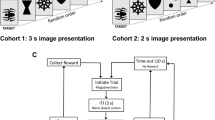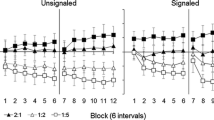Abstract
Performance on delayed matching-to-position as a function of ethanol was investigated in rats and dose effects assessed by fitting an exponential decay model of forgetting to signal detection sensitivity scores. Three ethanol doses (0.25, 0.50, and 0.75 g/kg) and one isovolume saline control were examined. For further comparison, one dose of chlordiazepoxide (CDP; 5 mg/kg) and its saline control were also given. Forgetting functions were reasonably well described by the decay model under all treatment conditions. In addition, the functions's decay constant (−b) proved to be differentially sensitive to both drug and dose effects. Reduced decay estimates were obtained following the two lowest ethanol doses, the reduction being statistically significant for the 0.25 g/kg dose. In contrast, the function estimate of initial sensitivity, the intercept parameter (SI0), was not significantly affected by ethanol. Consistent with the low-dose ethanol effects, CDP significantly decreased the value of the decay parameter while leaving the intercept parameter unaffected. But unlike ethanol, the variance accounted for by the model for the individual data was less following CDP administration. Drug effects were interpreted using the exponential decay model of forgetting, and the results suggest independent discriminative control over SI0 and b. The significant effect of the low-dose sedative-hypnotics upon b, with no attendant effects upon SI0, is suggested to result from enhanced, spontaneous, delay interval mediation.
Similar content being viewed by others
References
Barrett JE, Stanley JA (1980) Effects of ethanol on multiple fixed-interval fixed-ratio schedule performances: dynamic interactions at different fixed-ratio values. J Exp Anal Behav 34:185–198
Davison MC, Tustin RD (1978) The relation between the generalized matching law and signal-detection theory. J Exp Anal Behav 29:331–336
Devenport LD, Merriman VJ (1983) Ethanol and behavioral variability in the radial-arm maze. Psychopharmacology 79:21–24
Devenport LD, Merriman VJ, Devenport JA (1983) Effects of ethanol on enforced spatial variability in the 8-arm radial maze. Pharmacol Biochem Behav 18:55–59
Dunnett SB (1985) Comparative effects of cholinergic drugs and lesions of nucleus basalis or fimbria-formix on delayed matching in rats. Psychopharmacology 87:357–363
Dunnett SB, Evenden JL, Iversen SD (1988) Delay-dependent short-term memory deficits in aged rats. Psychopharmacology 96:174–180
Frey PW, Colliver JA (1973) Sensitivity and responsivity measures for discrimination learning. Learn Motiv 4:327–342
Glowa JR, Barrett JE (1976) Effects of alcohol on punished and unpunished responding of squirrel monkeys. Pharmacol Biochem Behav 4:169–173
Green DM, Swets JA (1966) Signal-detection theory and psychophysics. Wiley, New York
Jans JE, Catania AC (1980) Short-term remembering of discriminative stimuli in pigeons. J Exp Anal Behav 34:177–183
Katz JL, Barrett JE (1978) Effects of ethanol on behavior under fixed-ratio, fixed-interval, and multiple fixed-ratio fixed-interval schedules in the pigeon. Arch Int Pharmacodyn Ther 234:88–96
Katz JL, Barrett JE (1979) Effects ofd-amphetamine and ethanol alone and in combination on schedule-controlled responding of pigeons. Psychopharmacology 64:13–18
Kesner RP, Bierley RA, Pebbles P (1981) Short-term memory. The role ofd-amphetamine. Pharmacol Biochem Behav 15:673–676
Kirk RC, White KG, McNaughton N (1988) Low dose scopolamine affects discriminability but not rate of forgetting in delayed conditional discrimination. Psychopharmacology 96:541–546
Koob GF, Strecker RE, Bloom FE (1980) Effects of naloxone on the anticonflict properties of alcohol and chlordiazepoxide. Subst Alcohol Actions/Misuse 1:447–467
Koob GF, Thatcher-Britton K, Britton DR, Roberts D, Bloom FE (1984) Destruction of the locus coeruleus or the dorsal NE bundle does not alter the release of punished responding by ethanol and chlordiazepoxide. Physiol Behav 33:479–485
Koob GF, Braestrup C, Thatcher-Britton K (1986) The effects of FG 7142 and RO 15-1788 on the release of punished responding by chlordiazepoxide and ethanol in the rat. Psychopharmacology 90:173–178
Leander JD, McMillan DE, Ellis FW (1976) Ethanol and isopropanol effects on schedule-controlled responding. Psychopharmacology 47:157–164
Nevin JA (1970) On differential stimulation and differential reinforcement. In: Stebbins WC (Ed) Animal psychophysics. The design and conduct of sensory experiments Appleton-Century-Crofts, New York, (pp 401–423)
Nevin JA (1981) Psychophysics and reinforcement schedules. An integration. In: Commons ML, Nevin JA (eds) Quantitative analyses of behavior: vol 1. Discriminative properties of reinforcement schedules Ballinger, Cambridge, MA, (pp 3–27)
Nevin JA, Jenkins P, Whittaker S, Yarensky P (1982) Reinforcement contingencies and signal detection. J Exp Anal Behav 37:65–79
Sahgal A (1987a) Some limitations of indices derived from signal detection theory: evaluation of an alternative index for measuring bias in memory tasks. Psychopharmacology 91:517–520
Sahgal A (1987b) Contrasting effects of vasopressin, desglycinamide-vasopressin and amphetamine on a delayed matching to position task in rats. Psychopharmacology 93:243–249
Schandler SL, Cohen MJ, Naliboff BD (1984) Alcohol-influenced changes in activation peaking during paired-associate verbal learning. J Stud Alcohol 45:493–499
Sepinwall J, Cook L (1979) Behavioral pharmacology of antianxiety drugs. In: Iversen LL, Iversen SD, Snyder SH (eds) Handbook of psychopharmacology, vol 13. Plenum Press, New York
Subhan Z, Hindmarch I (1983) The effects of midazolam in conjunction with alcohol on iconic memory and free-recall. Neuropsychobiology 9:230–234
Suzdak PD, Glowa JR, Crawley JN, Schwartz RD, Skolnick P, Paul SM (1986) A selective imidazobenzodiazepine antagonist of ethanol in the rat. Science 234:1243–1247
Watson JE (1990) Quantification of the effects of chlorpromazine on performance under delayed matching-to-sample in pigeons. J Exp Anal Behav (in press)
White KG (1985) Characteristics of forgetting functions in delayed matching to sample. J Exp Anal Behav 44:15–34
White KG, McKenzie J (1982) Delayed stimulus control. Recall for single and relational stimuli. J Exp Anal Behav 38:305–312
Williams HL, Rundell OH (1984) Effect of alcohol on recall and recognition as functions of processing levels. J Stud Alcohol 45:10–15
Zentall TR, Hogan DE, Howard MM, Moore BS (1978) Delayed matching in the pigeon: effect on performance of sample-specific observing responses and differential delay behavior. Learn Motiv 9:202–218
Author information
Authors and Affiliations
Rights and permissions
About this article
Cite this article
Melia, K.F., Koob, G.F. & Ehlers, C.L. Ethanol effects on delayed spatial matching as modeled by a negative exponential forgetting function. Psychopharmacology 102, 391–398 (1990). https://doi.org/10.1007/BF02244109
Received:
Revised:
Issue Date:
DOI: https://doi.org/10.1007/BF02244109




